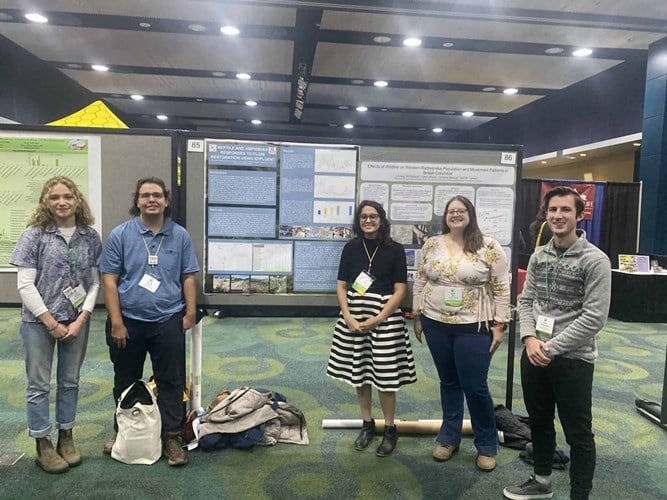
The Santa Cruz River hasn’t been a reliable source of water since European settlers changed the sustainable water use patterns of Indigenous people like the Hohokam in the late 1800s. Even before large farms began overdrawing from its sources in Arizona, the river water often dried up for entire seasons. Since the 1950s, until more recently, projects around Tucson have partly or fully restored water flow in some areas, but many parts of the riverbed still remain entirely dry year round.
Undergraduate researchers wanted to determine the effects that differences in water flow had on reptile and amphibian species richness and abundance. TWS member Riley Gallagher, an undergraduate student in rangeland management at the University of Arizona, and her colleagues surveyed four sites along the Santa Cruz River—some dry and some restored—around Tucson. Every other weekend, from February 2021 to August 2022, a team of students organized by the local TWS student chapter at the University of Arizona—would walk along both banks of the river, noting every species they came across.
“Everyone had a good understanding of the species that were there,” said Gallagher, vice president of the student chapter.
One of the sites had been restored perennially since the 1950s, while another was restored 3.5 years before the study period. A third site had water restored halfway through the study period, while the last site remained completely dry except for during the seasonal monsoons.
In a poster presented at The Wildlife Society’s 2022 Annual Conference in Spokane, the researchers found a total of 20 species of reptiles and amphibians at all of the sites. These included various species of whiptails, some that were hard to categorize due to interbreeding, and other species of lizards, snakes, turtles and toads. There were also invasive species like red-eared sliders (Trachemys scripta elegans) and American bullfrogs (Lithobates catesbeianus), which outcompete the local Sonoran Desert toad (Incilius alvarius). But some sites had more species richness and abundance than others.
The western whiptail (Cnemidophorus tigris) was the most abundant species found at all sites. But that lizard was mostly found in highest abundance at the site that had 70 years of water. The common side-blotched lizard (Uta stansburiana) was the species seen most often at the other three sites.
The least abundant species overall were the red-eared slider, Mediterranean house gecko (Hemidactylus turcicus) and the spiny softshell turtle (Apalone spinifera)—all nonnative species.
The best two sites for both species richness and abundance were the two that had water restored earlier. The site with 70 years of water and the site with 3.5 years of water both had 16 species of reptiles and amphibians, though these species weren’t exactly the same at each.
The site with water restored halfway through the study period saw a small change in species richness. The surveyors observed 11 species before and 13 species after.
“We didn’t see a huge increase in the species that were observed after the water was introduced,” Gallagher said. “It does take some time for species to become reestablished in the area.”
Many species were only found at wet sites. Those included the western diamondback rattlesnake (Crotalus atrox), Clark’s spiny lizard (Sceloporus magister), California kingsnake (Lampropeltis getula californiae), red spotted toad (Anaxyrus punctatus), checkered garter snake (Thamnophis marcianus) and spiny softshell turtle.
The dry riverbed only had seven species of reptiles and amphibians and none that weren’t also found at wet sites.
Gallagher said that these results reveal how water shortages, which many parts of the Southwest are experiencing, can affect wildlife richness and abundance. But water restoration projects appeared to improve this particular situation, though it took some time before species abundances caught up.
“Introducing effluent flow into a dry river can help increase species richness and abundance in an area,” Gallagher said.
Written by: Joshua Rapp Learn for The Wildlife Society; used with permission. Find the original article here.
Founded in 1978, the Council on Undergraduate Research (CUR) focuses on providing high-quality and collaborative undergraduate research, scholarly, and creative activity. Among the many activities and networking opportunities that CUR provides, the organization also offers support for the professional growth of faculty and administrators through expert-designed institutes, conferences, and a wide-range of volunteer positions. The CUR community, made up of nearly 700 institutions and 13,000 individuals, continues to provide a platform for discussion and other resources related to mentoring, connecting, and creating relationships centered around undergraduate research. CUR’s advocacy efforts are also a large portion of its work as they strive to strengthen support for undergraduate research. Its continued growth in connections with representatives, private foundations, government agencies, and campuses world-wide provides value to its members and gives voice to undergraduate research. CUR is committed to inclusivity and diversity in all of its activities and our community.
CUR focuses on giving a voice to undergraduate research with learning through doing. It provides connections to a multitude of campuses and government agencies, all while promoting networking and professional growth to its community.


